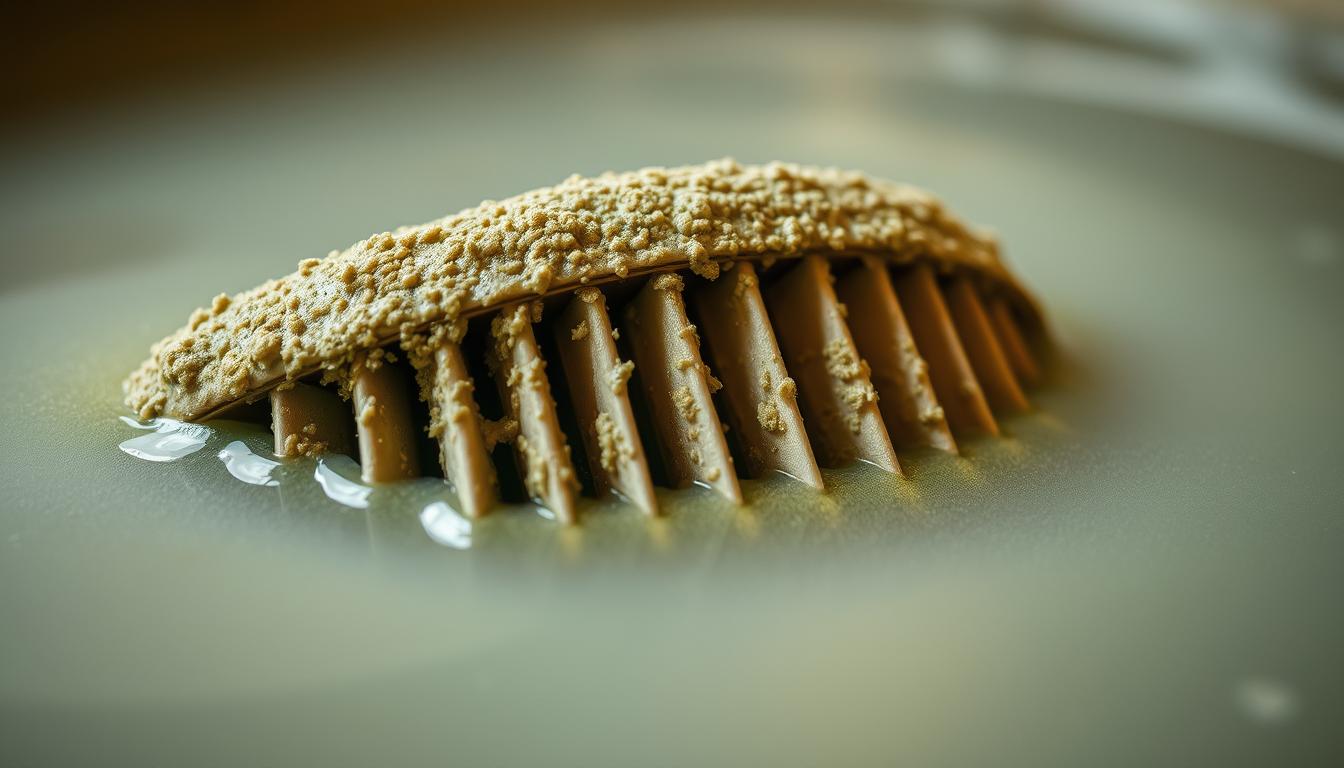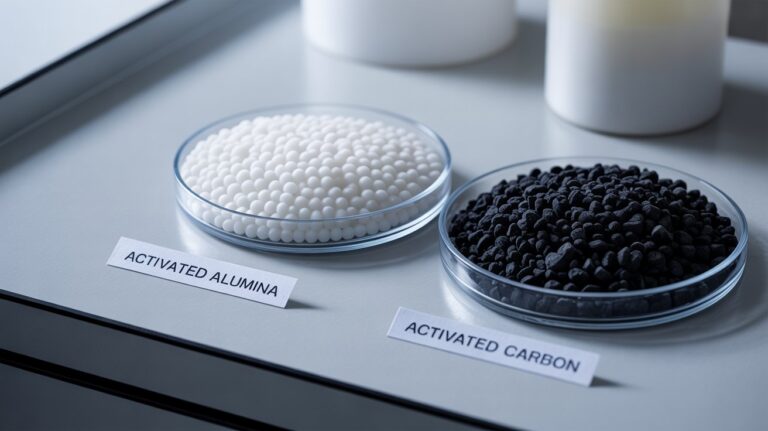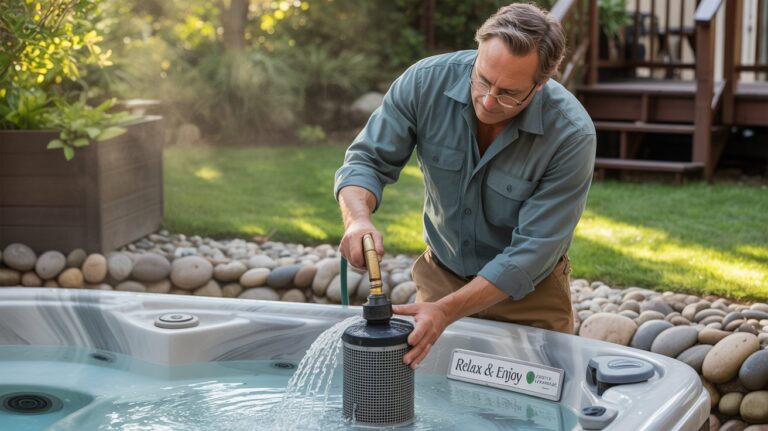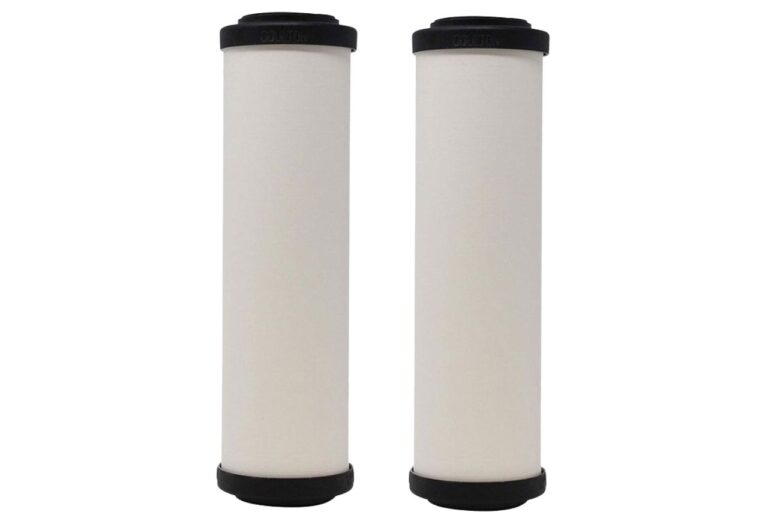Slimy Hot Tub Filter? What It Really Means
Have you ever slipped into your relaxing hot tub only to be greeted by a layer of slime on the filter? It’s a common issue that can turn a soothing experience into a frustrating one.
This slimy film, known as biofilm, is a buildup of bacteria that attaches itself to hard surfaces, including your hot tub’s plumbing. It’s not just aesthetically unpleasing; biofilm can also affect the overall performance and hygiene of your hot tub.
Understanding the causes and consequences of biofilm is crucial for maintaining a clean and safe hot tub. In this article, we’ll delve into the reasons behind the formation of slimy hot tub filters and provide you with effective hot tub maintenance tips to keep your tub in top condition.
Key Takeaways
- Biofilm is a slimy film of bacteria that can attach to hot tub surfaces.
- Regular maintenance is key to preventing biofilm buildup.
- Effective cleaning methods can help remove biofilm from filters.
- Proper hot tub maintenance ensures a safe and healthy soaking experience.
- Neglecting hot tub maintenance can lead to performance issues and health risks.
Understanding the Slimy Culprit: Why Is My Hot Tub Filter Slimy?
A slimy hot tub filter is not just a minor issue; it’s a sign of underlying problems that need attention. The slime is typically a result of biofilm formation, a complex community of microorganisms that adhere to the filter surfaces.
Biofilm Formation: The Science Behind the Slime
Biofilm thrives in warm, moist environments like hot tubs, especially when the water temperature exceeds 90°F. It’s fueled by organic materials introduced by bathers, such as sweat and body oils. When the sanitizer levels (chlorine or bromine) drop below the recommended minimum, bacteria can start to grow, forming a slimy biofilm on the filter. Proper sanitizer levels are crucial to prevent this growth.
Common Causes of Filter Slime
Several factors contribute to the formation of slime on hot tub filters. These include inadequate maintenance, poor water circulation, and insufficient sanitizer levels. Additionally, the presence of contaminants like lotions, sunscreens, and dirt from bathers can accelerate biofilm growth. Regularly checking and adjusting the water chemistry can help mitigate these issues.
Types of Hot Tub Filters and How They Get Dirty
Hot tub filters come in various types, including cartridge, sand, and diatomaceous earth (DE) filters. Each type has its unique characteristics and maintenance needs. Cartridge filters, for instance, are prone to biofilm formation if not regularly cleaned. Understanding the specific needs of your filter type is key to preventing slime buildup.
By addressing the root causes of slime formation and maintaining proper hot tub hygiene, you can enjoy a cleaner, healthier hot tub experience. Regular maintenance and monitoring of water chemistry are essential steps in preventing the return of slimy filters.
The Dangers of Ignoring Your Slimy Hot Tub Filter
Ignoring a slimy hot tub filter can have far-reaching consequences, impacting not just the filter itself but the entire hot tub system. The buildup of biofilm and bacteria on the filter can lead to a cascade of problems that affect the overall health and functionality of your hot tub.
Impact on Water Quality and Circulation
A slimy filter can significantly impair the water circulation in your hot tub, leading to poor water quality. When the filter is clogged with biofilm and debris, it can’t effectively clean the water, resulting in cloudy or dirty water. This not only affects the aesthetic appeal of your hot tub but also creates an environment conducive to the growth of harmful bacteria.
Potential Health Risks
The presence of biofilm on your hot tub filter poses serious health risks. Biofilm can harbor harmful bacteria, including Pseudomonas aeruginosa, which can cause skin infections and respiratory issues. If the filter is not properly maintained, these bacteria can be dispersed throughout the water, putting users at risk of infection.
Damage to Hot Tub Components and Systems
Neglecting a slimy hot tub filter can also lead to damage to other components and systems within your hot tub. The increased pressure and strain on the pump and heater can result in premature wear and tear, leading to costly repairs. Furthermore, the corrosion of metal parts due to improper water chemistry can further exacerbate the problem.
| Component | Potential Damage | Consequence |
|---|---|---|
| Pump | Increased strain due to clogged filter | Premature wear and tear |
| Heater | Overheating due to reduced water flow | Reduced lifespan |
| Metal Parts | Corrosion from improper water chemistry | Leaks and structural damage |
Signs Your Hot Tub Filter Needs Immediate Attention
Maintaining a clean and functional hot tub filter is essential for enjoying a relaxing and rejuvenating soak. A dirty or clogged filter can lead to a range of problems that affect not only the water quality but also the overall performance of your hot tub.
Visual Indicators of Filter Problems
One of the most obvious signs that your hot tub filter needs attention is visible dirt or debris accumulation. If you notice that your filter is clogged with dirt, oils, or other contaminants, it’s time to clean or replace it. Other visual indicators include a change in the filter’s color or the presence of slime and biofilm.
Performance Issues Related to Dirty Filters
A dirty or clogged filter can cause a range of performance issues, including reduced water circulation, increased pressure on the pump, and decreased heating efficiency. If you notice that your hot tub is taking longer to heat up or that the water is not circulating properly, it may be a sign that your filter needs attention.
| Performance Issue | Possible Cause | Solution |
|---|---|---|
| Reduced Water Circulation | Clogged Filter | Clean or Replace Filter |
| Increased Pressure on Pump | Dirty Filter | Clean Filter |
| Decreased Heating Efficiency | Clogged Filter | Clean or Replace Filter |
Water Quality Changes That Signal Filter Issues
Changes in water quality can also signal that your hot tub filter needs attention. If you notice that the water is becoming cloudy or that it’s difficult to maintain the proper chemical balance, it may be a sign that your filter is not functioning properly. Other signs include increased use of chemicals, difficulty keeping the water clear, and unpleasant odors from the water.
By being aware of these signs and taking prompt action, you can help maintain a clean, safe, and enjoyable hot tub experience.
Deep Cleaning Your Slimy Hot Tub Filter: Step-by-Step Guide
Deep cleaning your hot tub filter is an essential task that ensures your hot tub remains safe and enjoyable to use. A dirty filter can lead to a host of problems, from poor water circulation to increased risk of bacterial growth. In this section, we’ll walk you through the process of deep cleaning your slimy hot tub filter.
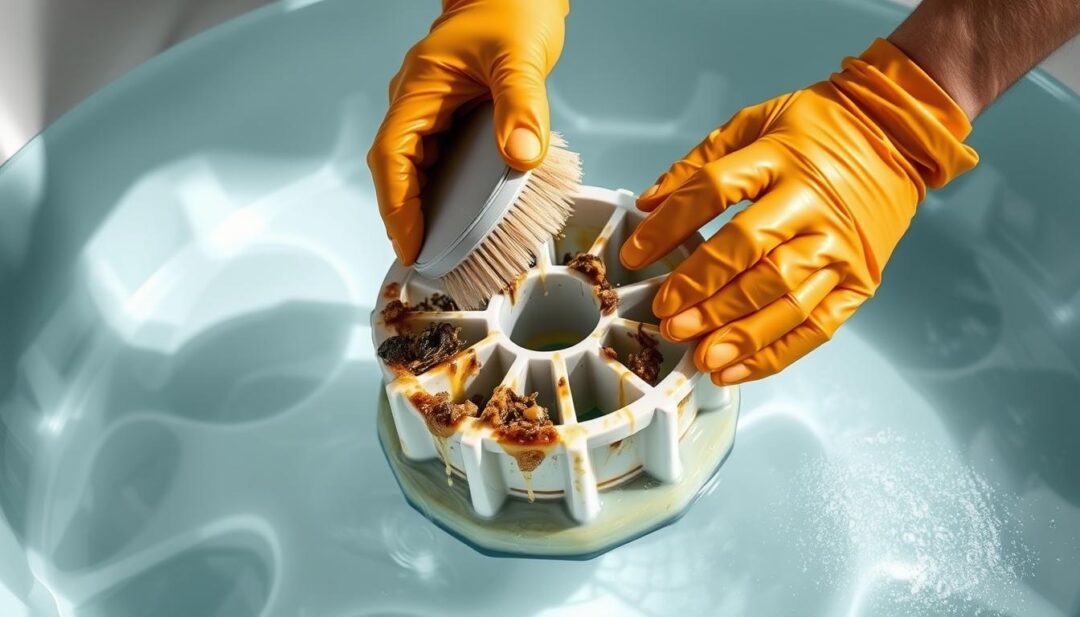
Supplies You’ll Need for Effective Cleaning
Before you start, make sure you have the necessary supplies. You’ll need a filter cleaning solution, a bucket large enough to hold your filter, and a soft-bristled brush. For more severe buildup, consider using a product specifically designed to remove biofilm, such as Ahh-some Tub cleaner. Additionally, having a sanitizer like chlorine or bromine on hand can be helpful.
The Cleaning Process Explained
To begin the cleaning process, first remove the filter from your hot tub and rinse it with a garden hose to remove any loose debris. Next, mix your filter cleaning solution with water in the bucket according to the product’s instructions. Submerge the filter in the solution and let it soak for the recommended time, usually several hours or overnight. After soaking, use the soft-bristled brush to gently scrub away any remaining buildup. Rinse the filter thoroughly with clean water to remove any residue.
For particularly stubborn buildup, you may need to repeat the soaking and scrubbing process. It’s also a good idea to clean your filter in a well-ventilated area to avoid inhaling any fumes from the cleaning solution.
Specialized Cleaning for Different Types of Buildup
Different types of buildup may require specialized cleaning approaches. For example, if your filter is suffering from mineral deposits due to hard water, you may need to use a product designed to remove these deposits. Similarly, if you’re dealing with algae or biofilm, a product like Ahh-some Tub cleaner can be very effective. Always follow the product instructions and take necessary safety precautions.
When to Replace vs. When to Clean
Not all dirty filters can be saved with cleaning. If your filter is old or has been neglected for a long time, it might be more cost-effective to replace it. As a general rule, if your filter is more than 2-3 years old or has visible signs of wear and tear, it’s likely time for a replacement. Otherwise, regular cleaning can help extend the life of your filter and keep your hot tub running smoothly.
“Regular maintenance is key to extending the life of your hot tub filter,” says a leading expert in hot tub maintenance. “By cleaning your filter regularly and addressing any underlying issues, you can enjoy a cleaner, safer hot tub experience.”
Hot Tub Water Chemistry: The Foundation of Filter Health
Hot tub water chemistry plays a pivotal role in preventing the buildup of unwanted contaminants on your filter. Maintaining the right chemical balance is not just about keeping the water clean; it’s also crucial for the longevity and effectiveness of your hot tub filter.
Chemical Balances to Maintain
To keep your hot tub water healthy and your filter functioning properly, several chemical balances must be maintained. These include:
- pH levels between 7.2 and 7.8
- Alkalinity levels between 80 and 120 ppm
- Calcium hardness between 150 and 250 ppm
- Sanitizer levels (chlorine or bromine) as recommended by the manufacturer
For instance, if the pH level is too high or too low, it can lead to scaling or corrosion, affecting not just the water quality but also the filter’s performance. Regularly checking and adjusting these chemical levels is essential for preventing biofilm formation and keeping your filter clean.
Testing Schedules and Procedures
Regular testing of your hot tub water is vital to ensure that the chemical balances are within the recommended ranges. It’s advisable to test the water at least once a week, or more frequently if the hot tub is used often. Testing should include pH, alkalinity, calcium hardness, and sanitizer levels.
| Parameter | Ideal Range | Testing Frequency |
|---|---|---|
| pH | 7.2 – 7.8 | Weekly |
| Alkalinity | 80 – 120 ppm | Weekly |
| Calcium Hardness | 150 – 250 ppm | Monthly |
| Sanitizer | As per manufacturer’s instructions | Daily/Weekly |
Consequences of Improper Chemistry
Failing to maintain proper hot tub water chemistry can lead to a range of issues, including the formation of biofilm on your filter. For example, improper pH levels can cause scaling or corrosion, while inadequate sanitizer levels can lead to the growth of algae and bacteria. For tips on preventing algae during extended periods away, you can refer to resources like this guide on algae prevention.
By understanding and managing your hot tub’s water chemistry, you can significantly reduce the risk of filter contamination and ensure a cleaner, healthier hot tub experience.
Preventative Maintenance: Stop Slime Before It Starts
Regular maintenance is the best way to ensure your hot tub filter remains slime-free and functional. By implementing a routine that includes regular cleaning, water chemistry checks, and other tasks, you can prevent the formation of biofilm and keep your hot tub in top condition.
Weekly Maintenance Tasks
To keep your hot tub filter clean and functional, it’s essential to perform certain tasks on a weekly basis. These tasks include:
- Checking and adjusting the water chemistry to ensure it’s within the recommended parameters.
- Running a shock treatment to oxidize any built-up contaminants.
- Inspecting the filter for signs of wear or damage.
By performing these tasks weekly, you can help prevent the buildup of biofilm and keep your hot tub water clean and safe.
Monthly Maintenance Schedule
In addition to weekly tasks, there are certain maintenance tasks that should be performed monthly to keep your hot tub in top condition. These tasks include:
| Task | Description |
|---|---|
| Deep clean the filter | Remove the filter and soak it in a cleaning solution to remove any built-up debris. |
| Inspect the hot tub’s plumbing | Check for signs of wear or damage and perform any necessary repairs. |
| Check and replace the water | If necessary, drain and refill the hot tub to maintain optimal water quality. |
Seasonal Care Tips
As the seasons change, there are certain tasks you can perform to keep your hot tub in top condition. For example, during the winter months, you may need to adjust your maintenance schedule to account for colder temperatures. As John Smith, a hot tub expert, notes, “Regular maintenance is key to extending the life of your hot tub and its components.”
“A well-maintained hot tub is a joy to use, and with the right maintenance routine, you can enjoy it for years to come.”
Filter Rotation Strategy
If you have a dual-filter system, it’s essential to rotate the filters regularly to ensure even wear and tear. This can help extend the life of your filters and prevent slime buildup.

Troubleshooting Persistent Slimy Filter Issues
If your hot tub filter remains slimy despite regular maintenance, it’s time to dig deeper into the problem. Persistent slime can be a sign of underlying issues that need to be addressed to keep your hot tub in good working condition.
When Regular Cleaning Isn’t Enough
Sometimes, regular cleaning isn’t enough to resolve slimy filter issues. This can be due to the type of contaminants in the water or the filter’s design. In such cases, it’s essential to identify the root cause of the problem.
| Cause | Symptoms | Solution |
|---|---|---|
| Biofilm Formation | Slime on the filter, cloudy water | Deep cleaning or replacing the filter |
| Hard Water | Mineral deposits, scaling | Using a water softener or scale remover |
| Algae Growth | Greenish water, slimy filter | Shock treatment, algaecide application |
Addressing Underlying Water Problems
Underlying water problems, such as improper chemical balance or contamination, can lead to slimy filters. Regular water testing and balancing are crucial to prevent such issues.
Key water parameters to check include:
- pH levels
- Alkalinity
- Calcium hardness
- Sanitizer levels
Dealing with Hard Water and Mineral Buildup
Hard water can cause mineral buildup on the filter, leading to slime and reduced efficiency. Using a water softener or a scale remover can help mitigate this issue.
Solving Algae-Related Filter Problems
Algae growth can contribute to slimy filters. Implementing shock treatments and using algaecides can help control algae and keep the filter clean.
Regular maintenance and monitoring are key to preventing algae-related issues.
By addressing these potential causes and implementing the suggested solutions, you can troubleshoot and resolve persistent slimy filter issues, ensuring your hot tub remains clean and safe to use.
Professional vs. DIY Solutions for Slimy Hot Tub Filters
Dealing with a slimy hot tub filter requires a decision: should you invest in professional services or try to tackle the problem with DIY solutions? Both approaches have their merits, and the best choice depends on the severity of the issue, your budget, and your comfort level with DIY maintenance.
When to Call in the Experts
There are situations where calling in professionals is the best course of action. If you’ve tried cleaning your filter multiple times and it remains clogged, or if you’re unsure about the type of buildup you’re dealing with, it’s time to seek expert help. Professionals have the equipment and knowledge to diagnose and fix complex issues, including persistent biofilm or mineral buildup.
Cost-Effective Home Remedies That Actually Work
For those who prefer a DIY approach, there are several cost-effective home remedies that can be effective. One popular method is using a mixture of white vinegar and water to soak the filter. The acid in the vinegar helps break down mineral deposits and biofilm. Another remedy involves using baking soda to neutralize alkalinity and odors. It’s essential to rinse the filter thoroughly after using any cleaning solution to prevent residue buildup.
| Remedy | Effectiveness | Cost |
|---|---|---|
| Vinegar Soak | High | $5-$10 |
| Baking Soda Treatment | Medium | $2-$5 |
Commercial Products Worth the Investment
When home remedies aren’t enough, commercial products can provide a more potent solution. Filter cleaning solutions specifically designed for hot tubs can effectively remove tough buildup. Some popular products include filter cleaning sprays and degreasers. While these products may cost more than home remedies, they are often more effective and can extend the life of your filter.
In conclusion, whether you choose a professional or DIY solution for your slimy hot tub filter depends on your specific situation. By understanding the options available and their respective benefits, you can make an informed decision that keeps your hot tub running smoothly and efficiently.
Conclusion: Keeping Your Hot Tub Filter Slime-Free
Maintaining a slime-free hot tub filter requires ongoing effort, including regular cleaning, proper water chemistry, and preventative maintenance. By understanding the causes of slime buildup and implementing the strategies discussed in this article, you can enjoy a cleaner, healthier hot tub experience.
Regular cleaning and maintenance are crucial for keeping your hot tub filter in good condition. This includes checking and balancing your hot tub’s water chemistry, cleaning the filter regularly, and performing preventative maintenance tasks. By following these steps, you can prevent slime buildup and ensure your hot tub remains safe and enjoyable to use.
By incorporating these practices into your hot tub maintenance routine, you’ll be able to keep your hot tub filter slime-free and enjoy a relaxing soak whenever you want. A well-maintained hot tub is not only a pleasure to use, but it also provides a summary of good hot tub maintenance practices to follow.

